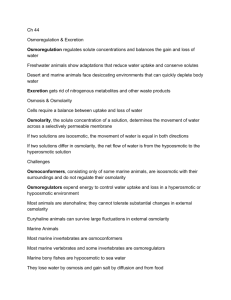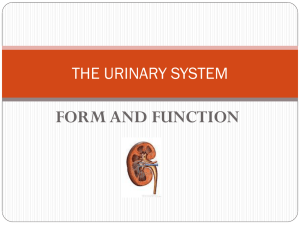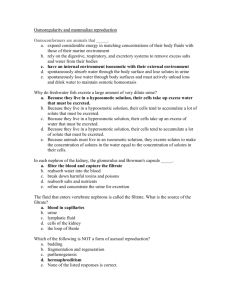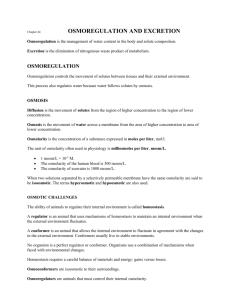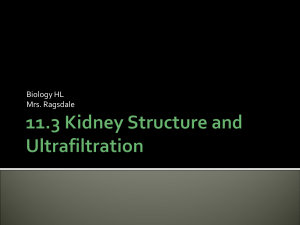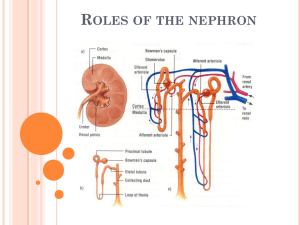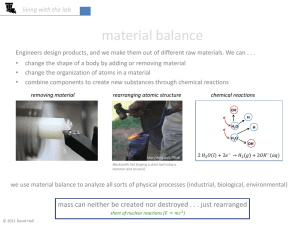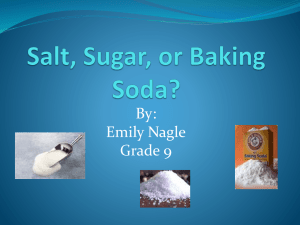Chapter 44 Final
advertisement
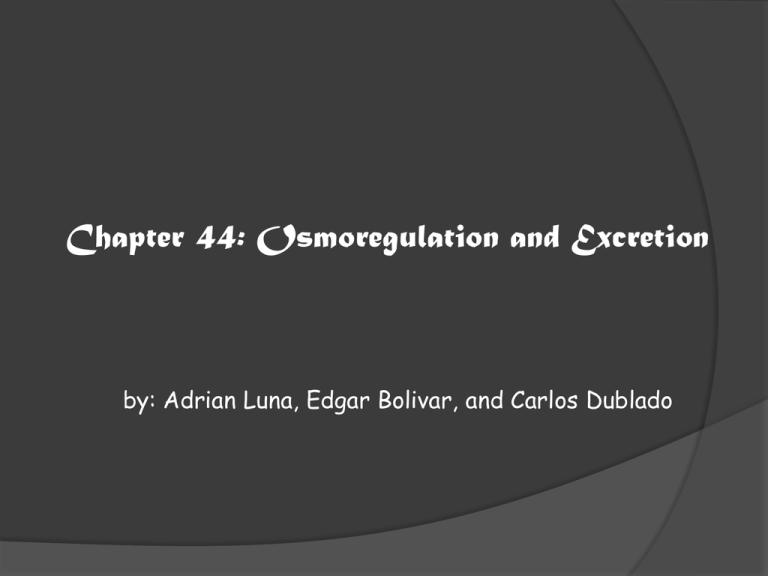
Chapter 44: Osmoregulation and Excretion by: Adrian Luna, Edgar Bolivar, and Carlos Dublado Overview • Systems of animals operate within a fluid environment • Concentrations of water/solutes must be maintained so systems could function properly, often against an animal’s external environment • Another problem = how to dispose of certain, sometimes toxic, metabolic wastes • Two homeostatic processes: – Osmoregulation is how animals regulate solute concentrations and balance gain and loss of water – Excretion is how animals get rid of nitrogen-containing waste products of their metabolism 44.1: Osmoregulation balances the uptake and loss of water and solutes • Like thermoregulation depends on balancing heat loss/gain, osmoregulation depends on balancing uptake/loss of water/solutes • Osmoregulation based largely on movement of solutes between internal fluids and external environment • Must remove metabolic waste products before accumulating to harmful levels Osmosis • All animals face same central problem of osmotic balance • Too much water = swell and burst • Not enough water = shrivel up and die • Osmolarity (total solute concentration) – Osmosis occurs whenever two solutions of different osmotic pressure • Isoosmotic – two solutions with same osmolarity separated by selectively permeable membrane • Hyperosmotic = solution with higher osmolarity • Hypoosmotic = solution with lesser (more dilute) osmolarity Osmotic Challenges • Two solutions to osmotic balance dilemma: • Osmoconformer = animal does not actively adjust its internal osmolarity; usually isoosmotic to environment • Osmoregulator = animal must control its internal osmolarity because body fluids are not isoosmotic to environment • either discharge/take in water to balance osmotic loss depending environment’s osmolarity • Osmoregulators use energy to maintain osmotic gradient; done so with active transport Land Animals • Terrestrial animals have adaptated to reduce water loss, due to threat of desiccation, allows survival on land • Most land animals still release considerable amounts of water through gas exchange, urine, feces, and across their skin • Balance kept by drinking and eating moist foods and by using metabolic waters derived from cellular respiration Transport Epithelia • Animals maintain composition of cellular cytoplasm by managing an internal body fluid that bathes their cells • Maintenance of fluid composition depends on specialized structures (transport epithelia or kidney) • Transport epithelia = a layer or layers of specialized epithelial cells, regulate solute movements; essential to osmotic regulation and metabolic waste disposal • Move specific solutes in controlled amounts in specific directions • Joined by impermeable tight junctions and serve as a barrier, ensuring solutes pass through their selectively permeable membrane • Transport epithelia often have dual functions of maintaining water balance and disposing of metabolic wastes 44.2: An animal’s nitrogenous wastes reflect its phylogeny and habitat • Most metabolic wastes have to be dissolved in water for disposal, potentially have some kind of influence on water balance depending on size/quantity • Nitrogenous wastes are among the most important wastes products in terms of effect on osmoregulation • When proteins and nucleic acids are broken down/converted into fats/carbohydrates, enzymes remove nitrogen in the form of the toxic molecule ammonia • Ammonia could be converted into something less toxic before secretion but only with the aid of ATP Forms of Nitrogenous Waste • Three different forms: ammonia, urea, and uric acid • differ in solubility, toxicity, and energy costs Ammonia • Is soluble but only tolerated at low concentrations because of high toxicity • animals that excrete it directly need access to a lot of water • common among aquatic species • Molecules easily pass through membranes and lost by diffusion to surrounding water – Many invertebrates release it across whole surface of body – Some fishes lose it as ammonium ions (NH₄⁺) across the epithelium of the gills Urea • Since ammonia is highly toxic, can only be excreted in large masses of dilute solutions containing water • many terrestrial and marine animals do not have access to sufficient water to make up for loss • So mammals excrete urea, a substance produced in liver by a metabolic cycle that combines ammonia with carbon dioxide • has a substantially lower toxicity than ammonia • could be stored and transported at much higher concentrations • excretion requires less water, is released in a concentrated solution rather than a dilute one (like ammonia) • a disadvantage is the expense of energy in the synthesis of the substance Uric Acid • Used by animals, like reptiles and birds, and is relatively nontoxic like its counterpart urea • It is highly insoluble in water, usually excreted as a solid paste with little water loss; it is more energetically expensive to make than urea The Influence of Evolution and Environment on Nitrogenous • The form of nitrogenous waste excreted depends on animal’s evolutionary history and habit, especially with water – Urea/uric acid are adaptations for excretion with minimal water loss • Mode of reproduction has been a factor in determining form of nitrogenous waste excreted • Another factor is the animal’s habitat • Amount of nitrogenous waste produced depends on the kind and amount of food an animal eats – Endotherms produce more nitrogenous wastes than ectotherms 44.3: Diverse excretory systems are variations on a tubular theme • Excretory system largely in charge of managing osmotic balance, depends on regulating solute movement between the internal fluids and external environment • Central to homeostasis because it disposes of metabolic wastes and controls body fluid composition by adjusting rates of solute loss Excretory Processes • Urine (fluid waste) produced by nearly all excretory systems involving several steps • Excretory tubules collect fluid (by filtration) called filtrate through selectively permeable membranes of transport epithelium from the body fluids (e.g. blood and hemolymph) • Large molecules unable to diffuse, hydrostatic pressure (blood pressure) forces water and small solutes like salts, sugars, and nitrogenous wastes into excretory tubules • Filtration is nonselective, essential small molecules need to be recovered and returned to body fluids; done so with selective reabsorption, which uses active transport to absorb valuable solutes • Nonessential solutes (excess salts and toxins) are left in the filtrate or added by selective secretion (also uses active transport) • The movement of solutes helps adjust osmotic movement of water in/out of filtrate • Filtrate is then excreted out of the system and body as urine Survey of Excretory Systems Excretory systems differentiate, but all revolve around the structure of a complex network of tubules that provide for exchange of water and solutes Concept 44.4 Nephrons and associated blood vessels • The Excretory system is centered on the kidneys – the site of water balance and salt regulation • Mammals have two bean-shaped kidneys – Blood supply comes from the renal artery – The renal vein drains the blood • Urine exits the kidneys through the ureter which drains into the urinary bladder and exits the body through the urethra Structure and Function of the Nephron and Associated Structures • Kidneys have 2 regions: – An outer renal cortex – An inner renal medulla • The nephron is a tubule with a ball of capillaries at one end called the glomerulus • Each kidney has about 1 million nephrons • Surrounding the glomerulus is the Bowman’s capsule • Blood comes into the glomerulus through the afferent arteriole and the blood pressure forces fluids into the Bowman’s capsule – Porous capillaries and special cells of the capsule (podocytes) are permeable to water and small solutes but not blood cells or large molecules like plasma proteins – Filtration is non-selective, meaning the Bowman's capsule is filled with both wastes and molecules (salts, glucose, amino acids and vitamins) Pathway of the Filtrate • From Bowman's capsule the filtrate passes through 3 regions: – Proximal tubule – The loop of Henle, a hairpin turn with a descending and ascending limb – And the distal tube • From each nephrons’ distal tubule, the filtrate empties into a collecting duct • From the collecting duct, the filtrate flows into the renal pelvis which is drained by the ureter Two Types of Nephrons • Cortical nephrons have reduced loops of Henle and are confined to the renal cortex, they make up 80% of a mammals nephrons • Juxtamedullary nephrons make up the other 20%, they have well developed loops extending deeply into the renal medulla – Only mammals and birds have juxtamedullary nephrons, the nephrons of other vertebrates lack a loop Henle altogether – Juxtamedullary nephrons allow mammals to make urine that is hyperosmotic to body fluids – an adaptation important to water conservation • As capillaries converge and leave the glomerulus they form the efferent arteriole which divides again forming peritubular capillaries that surround the proximal and distal tubules • The capillaries that extend downwards form the vasa recta – They also form a loop with the ascending and descending vessels conveying blood in opposite directions – Although they associate, there is no direct movement of materials •They're immersed in interstitial fluid through which substances can diffuse between capillaries and filtrate •Exchange is usually facilitated by blood and filtrate flow From Blood to Filtrate A Closer Look 1) Proximal tubule secretion and reabsorption alter volume and composition of filtrate. Cells in the tubule can synthesize and secrete ammonia to neutralize acid The proximal tubule also reabsorbs about 90% of bicarbonate(HCO3-) an important buffer Drugs and other poisons processed in the liver pass from the peritubular capillaries into the interstitial fluid to be secreted across the epithelium of the proximal tube into the nephrons lumen Conversely, valuable nutrients like glucose, amino acids and potassium (K+) are actively and passively transported from the filtrate to the peritubular capillaries One of the most important functions of the proximal tubule is the reabsorption of most NaCl (salt) and water – Salt diffuses into the cells of the transport epithelium whose membranes actively transport Na+ – This positive transport is balanced by the passive transport of Cl- out – As salt passes through, water follows by osmosis – To stop water and salt from coming back into the tubule, the outside of the epithelium has a smaller surface area than the side facing the lumen, instead, they diffuse into the capillaries 2) In the descending limb of the loop of Henle reabsorption of water continues as the filtrate passes Here the transport epithelium is freely permeable to water but not to salt or other solutes Osmosis only occurs if the interstitial fluids hyperosmotic to filtrate Osmolarity of the interstitial fluid Beacons greater from the outer cortex to the inner medulla of the kidney -> filtrate moving down the cortex to the medulla in the descending limb continually loses water increasing solute concentration 3) In the ascending limb of the loop of Henle the filtrate reaches the tip of the loop and travels up the limb In contrast to the descending limb, the ascending limb is permeable to salt but not to water 2 specialized regions: – Thin segment near the loop tip where NaCl diffuse out – Thick segment which actively transports NaCl 4) The distal tubule regulates K+ and NaCl concentrations by varying the amount of K+ secreted into the filtrate and the NaCl absorbed out Like the primal tubule, the distal tubule also regulates pH by secreting H+ and absorbing bicarbonate 5) The collecting duct carries filtrate through the medulla to the renal pelvis By collecting NaCl the duct can control how much salt is excreted through the urine Its degree of permeability is usually under hormonal control, however it is permeable to water but not to salt or urea in renal cortex -> because water is taken out the filtrate becomes more concentrated/urea The inner medulla becomes permeable to urea and because of its high concentration some diffuses out of the duct and into the fluid Along with NaCl, urea contributes to high osmolarity of interstitial fluid in the medulla enabling kidneys to conserve water by excreting urine that is hyperosmotic to general body fluids 44.5 The mammalian kidney’s ability to conserve water • loop of Henle and collecting ducts largely responsible for osmotic gradient that concentrates urine • Two primary solutes: – NaCl, deposited in renal medulla by loops of Henle – Urea, leaks across epithelium of collecting duct in inner medulla Solute Gradients and Water Conservation • As filtrate flows through Bowman’s capsule to proximal tubule, osmolarity of 300 mosm/L – Reabsorbs water and salt in the renal cortex, volume decreases but osmolarity remains the same • From cortex to medulla in descending limb, water leaves tubule (osmosis) – Filtrate’s osmolarity increases as solutes become concentrated • Ascending limb is permeable to NaCl but not water – NaCl diffuses to maintain high osmolarity in interstitial fluid of renal medulla • Countercurrent multiplier systems – expend energy to create concentration gradients – loop of Henle expends energy to actively transport NaCl from filtrate in upper part of ascending limb • Vasa recta is a countercurrent system – Prevents capillaries from dissipating gradient by carrying away high concentration of NaCl in medulla’s interstitial fluid – As descending vessel conveys blood toward inner medulla, water is lost and NaCl diffuses into it – In ascending vessel, water reenters and salt diffuses out • When filtrate reaches distal tubule, it is hypoosmotic to body fluids – Descends toward the medulla, via collecting duct (permeable to water, not salt) • Concentrates salt, urea, and other solutes in filtrate • Before leaving kidney, urine may attain osmolarity of interstitial fluid in inner medulla (as high as 1200 mosm/L) • High osmolarity allows solutes to be excreted with minimal water loss Regulation of Kidney Function • Osmoregulatory function managed with combination of nervous and hormonal controls – Hyperosmotic = low water, high salt – Hypoosmotic = high water, low salt • Antidiuretic hormone (ADH) – regulates water balance – Produced in hypothalamus of the brain – stored in and released from posterior pituitary gland – Main targets of ADH are distal tubules and collecting ducts, increases permeability of epithelium to water – When osmolarity of blood reaches a set point, more/less ADH is released • Juxtaglomerular apparatus (JGA) – specialized tissue located near afferent arteriole – Supplies blood to glomerulus – When blood pressure/volume drops in afferent arteriole, enzyme renin initiates chemical reactions, converts angiotensinogen to angiotensin II •raises blood flow to capillaries •Stimulates proximal tubules to reabsorb more salt and water, reducing amount of salt and water excreted and raises blood volume/pressure •Also stimulates adrenal glands, releases aldosterone, allows distal tubules to reabsorb more sodium (Na+) and water, increasing blood volume/pressure • Summarizing the renin-angiotensinaldosterone system (RAAS) – Drop in blood pressure/volume triggers renin release from JGA – Rise in blood pressure/volume resulting from actions of angiotensin II and aldosterone reduce renin • ADH alone lowers Na+ concentration by stimulating water reabsorption in the kidney – RAAS maintains balance by stimulating Na+ reabsorption • Atrial natriuretic factor (ANF) another hormone, opposes the RAAS – walls of atria of the heart release ANF in response to increase in blood volume/pressure • ANF lowers blood volume/pressure – Inhibits release of renin from JGA – Inhibits NaCl reabsorption by collecting ducts – And reduces aldosterone release from adrenal glands 44.6 Adaptations of the vertebrate kidney • Evolved in different environments • Variations in nephron structure/function allows for different osmoregulation in various habitats • All organs work continuously, maintaining solute/water balance and excreting nitrogenous wastes
